Coaching and Mentoring Approaches: Bhutanese Education Sector Analysis
VerifiedAdded on 2022/12/22
|11
|2712
|96
Report
AI Summary
This report analyzes coaching and mentoring approaches within the context of the Bhutanese education sector. It begins by identifying and describing two key models: peer coaching, based on the Joyce and Showers model, and formal mentoring. The report delves into the theoretical underpinnings of each approach, explaining their core principles and practical applications. A significant portion of the report is dedicated to reviewing and analyzing each model through the lens of contemporary research and literature, exploring the benefits, challenges, and empirical evidence supporting their use. The analysis includes a critical examination of the validity and credibility of both peer coaching and formal mentoring, drawing on research to justify the conclusions. The report considers the strengths and weaknesses of each approach, evaluating their suitability for enhancing teaching and learning outcomes within the Bhutanese educational system. Ultimately, the report provides a comprehensive overview of coaching and mentoring, offering insights into their potential to improve the quality of education.
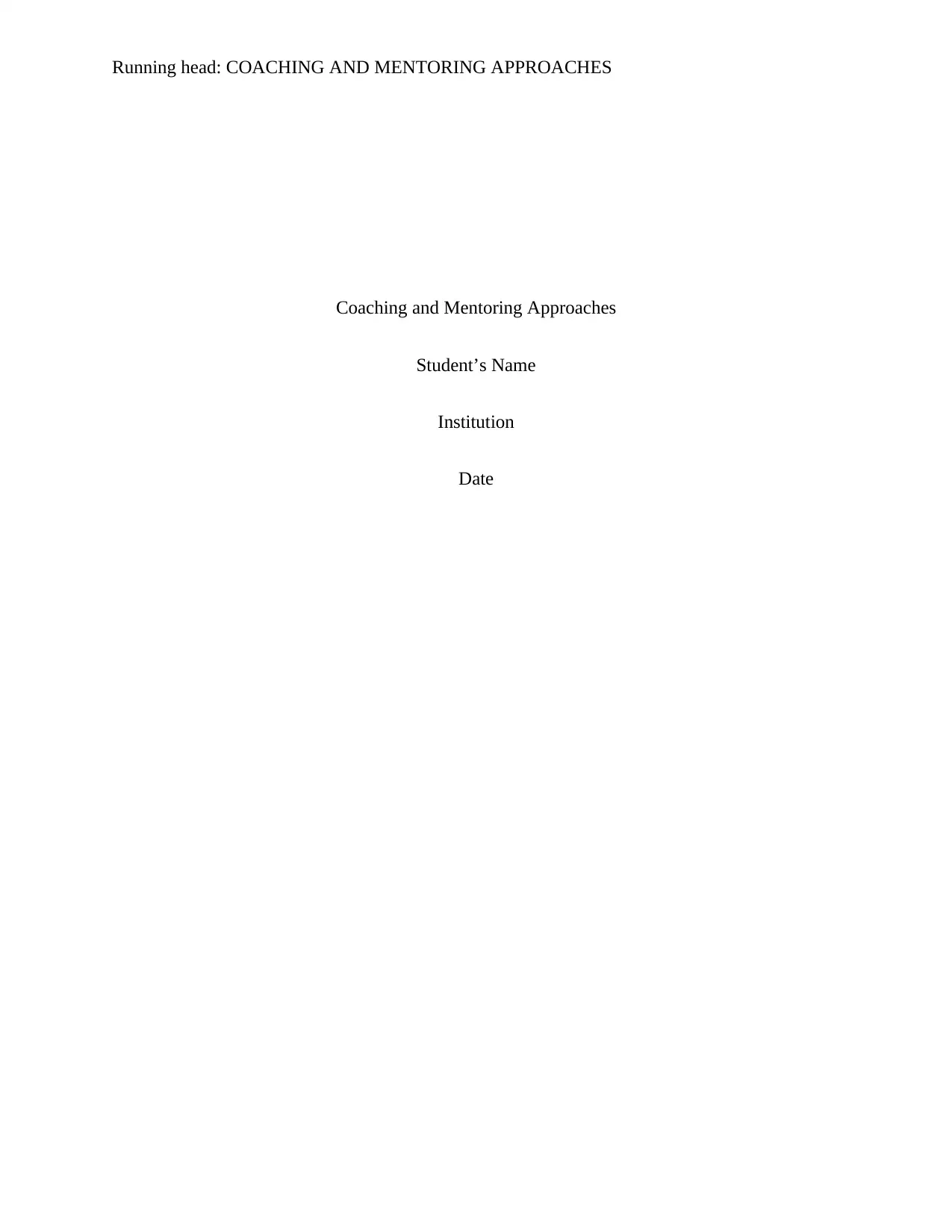
Running head: COACHING AND MENTORING APPROACHES
Coaching and Mentoring Approaches
Student’s Name
Institution
Date
Coaching and Mentoring Approaches
Student’s Name
Institution
Date
Paraphrase This Document
Need a fresh take? Get an instant paraphrase of this document with our AI Paraphraser
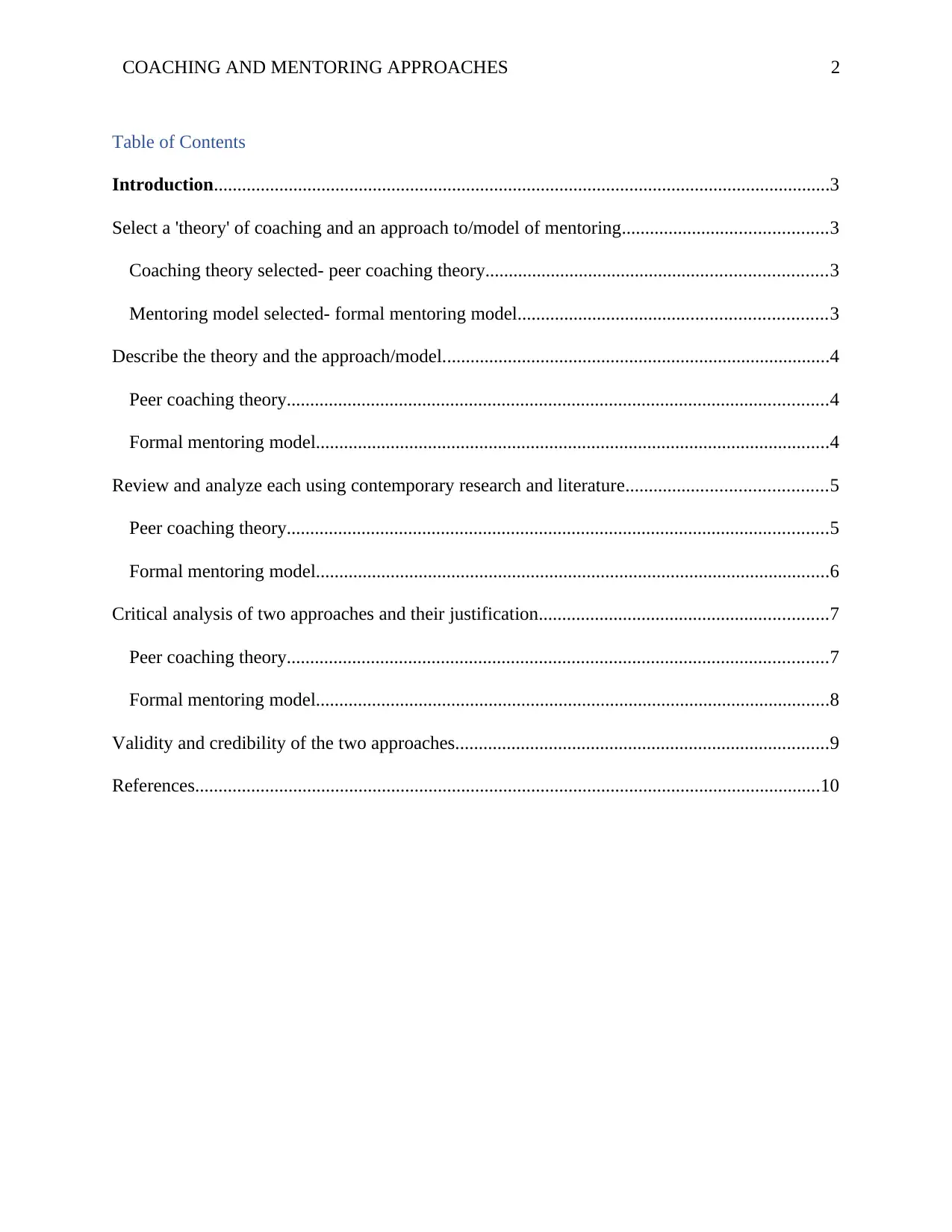
COACHING AND MENTORING APPROACHES 2
Table of Contents
Introduction....................................................................................................................................3
Select a 'theory' of coaching and an approach to/model of mentoring............................................3
Coaching theory selected- peer coaching theory.........................................................................3
Mentoring model selected- formal mentoring model..................................................................3
Describe the theory and the approach/model...................................................................................4
Peer coaching theory....................................................................................................................4
Formal mentoring model..............................................................................................................4
Review and analyze each using contemporary research and literature...........................................5
Peer coaching theory....................................................................................................................5
Formal mentoring model..............................................................................................................6
Critical analysis of two approaches and their justification..............................................................7
Peer coaching theory....................................................................................................................7
Formal mentoring model..............................................................................................................8
Validity and credibility of the two approaches................................................................................9
References......................................................................................................................................10
Table of Contents
Introduction....................................................................................................................................3
Select a 'theory' of coaching and an approach to/model of mentoring............................................3
Coaching theory selected- peer coaching theory.........................................................................3
Mentoring model selected- formal mentoring model..................................................................3
Describe the theory and the approach/model...................................................................................4
Peer coaching theory....................................................................................................................4
Formal mentoring model..............................................................................................................4
Review and analyze each using contemporary research and literature...........................................5
Peer coaching theory....................................................................................................................5
Formal mentoring model..............................................................................................................6
Critical analysis of two approaches and their justification..............................................................7
Peer coaching theory....................................................................................................................7
Formal mentoring model..............................................................................................................8
Validity and credibility of the two approaches................................................................................9
References......................................................................................................................................10
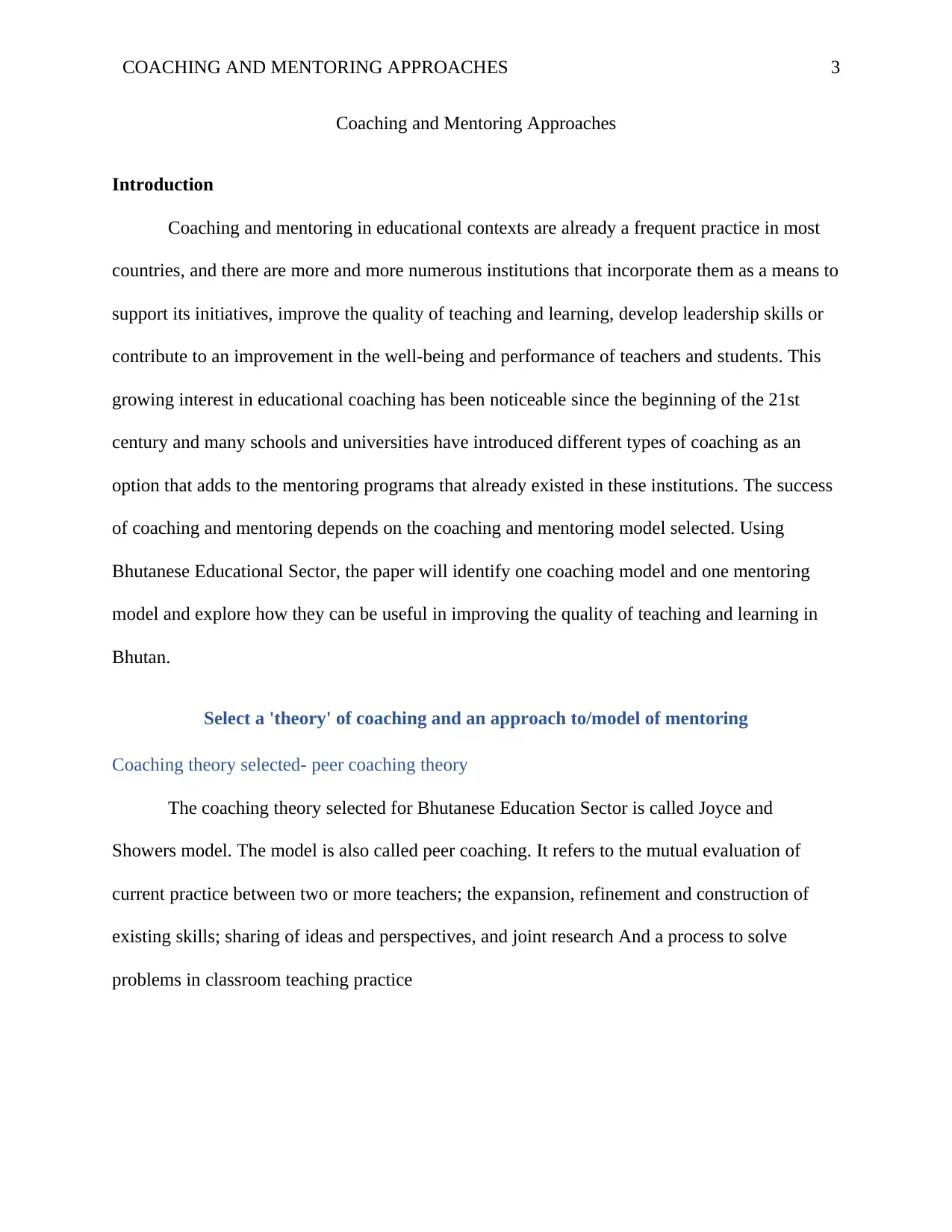
COACHING AND MENTORING APPROACHES 3
Coaching and Mentoring Approaches
Introduction
Coaching and mentoring in educational contexts are already a frequent practice in most
countries, and there are more and more numerous institutions that incorporate them as a means to
support its initiatives, improve the quality of teaching and learning, develop leadership skills or
contribute to an improvement in the well-being and performance of teachers and students. This
growing interest in educational coaching has been noticeable since the beginning of the 21st
century and many schools and universities have introduced different types of coaching as an
option that adds to the mentoring programs that already existed in these institutions. The success
of coaching and mentoring depends on the coaching and mentoring model selected. Using
Bhutanese Educational Sector, the paper will identify one coaching model and one mentoring
model and explore how they can be useful in improving the quality of teaching and learning in
Bhutan.
Select a 'theory' of coaching and an approach to/model of mentoring
Coaching theory selected- peer coaching theory
The coaching theory selected for Bhutanese Education Sector is called Joyce and
Showers model. The model is also called peer coaching. It refers to the mutual evaluation of
current practice between two or more teachers; the expansion, refinement and construction of
existing skills; sharing of ideas and perspectives, and joint research And a process to solve
problems in classroom teaching practice
Coaching and Mentoring Approaches
Introduction
Coaching and mentoring in educational contexts are already a frequent practice in most
countries, and there are more and more numerous institutions that incorporate them as a means to
support its initiatives, improve the quality of teaching and learning, develop leadership skills or
contribute to an improvement in the well-being and performance of teachers and students. This
growing interest in educational coaching has been noticeable since the beginning of the 21st
century and many schools and universities have introduced different types of coaching as an
option that adds to the mentoring programs that already existed in these institutions. The success
of coaching and mentoring depends on the coaching and mentoring model selected. Using
Bhutanese Educational Sector, the paper will identify one coaching model and one mentoring
model and explore how they can be useful in improving the quality of teaching and learning in
Bhutan.
Select a 'theory' of coaching and an approach to/model of mentoring
Coaching theory selected- peer coaching theory
The coaching theory selected for Bhutanese Education Sector is called Joyce and
Showers model. The model is also called peer coaching. It refers to the mutual evaluation of
current practice between two or more teachers; the expansion, refinement and construction of
existing skills; sharing of ideas and perspectives, and joint research And a process to solve
problems in classroom teaching practice
⊘ This is a preview!⊘
Do you want full access?
Subscribe today to unlock all pages.

Trusted by 1+ million students worldwide
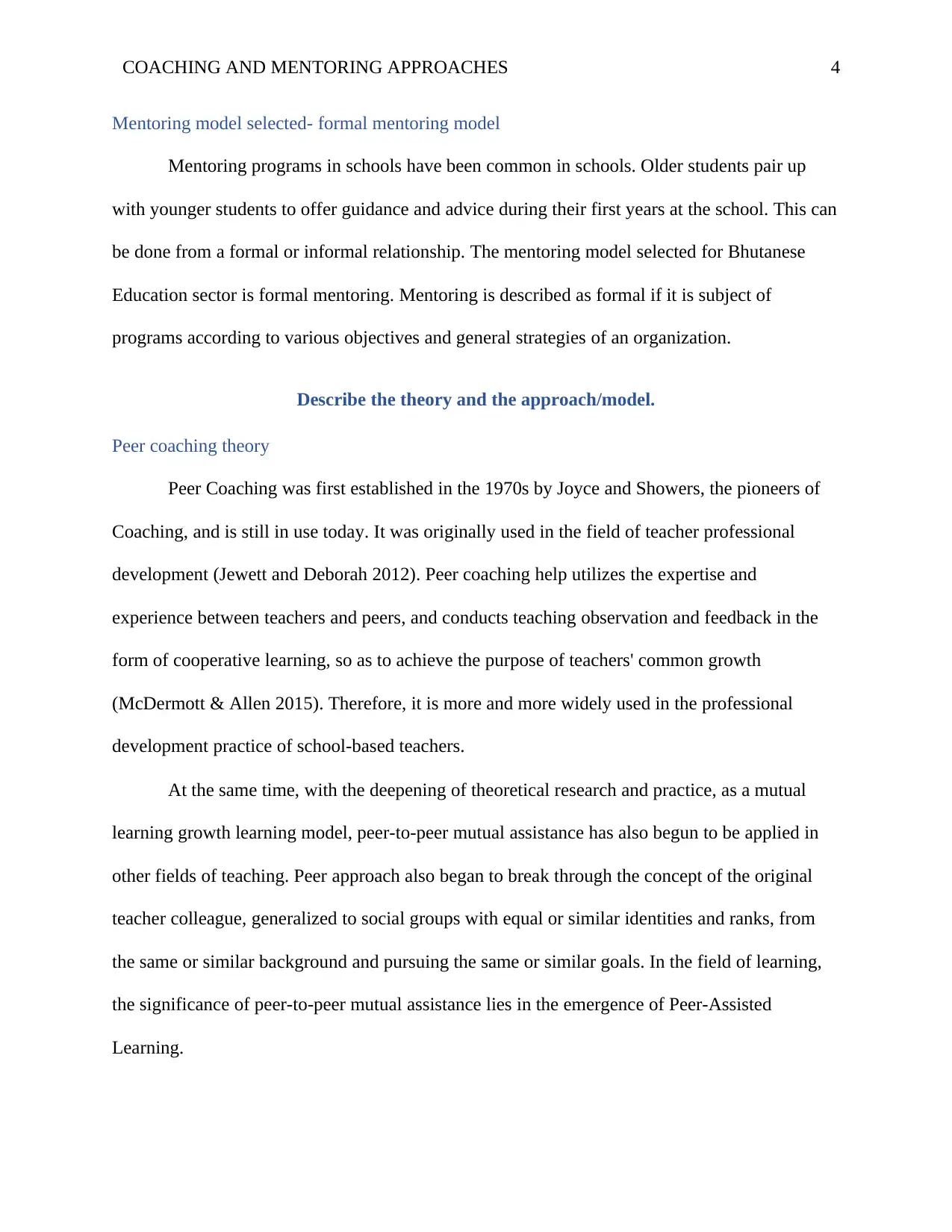
COACHING AND MENTORING APPROACHES 4
Mentoring model selected- formal mentoring model
Mentoring programs in schools have been common in schools. Older students pair up
with younger students to offer guidance and advice during their first years at the school. This can
be done from a formal or informal relationship. The mentoring model selected for Bhutanese
Education sector is formal mentoring. Mentoring is described as formal if it is subject of
programs according to various objectives and general strategies of an organization.
Describe the theory and the approach/model.
Peer coaching theory
Peer Coaching was first established in the 1970s by Joyce and Showers, the pioneers of
Coaching, and is still in use today. It was originally used in the field of teacher professional
development (Jewett and Deborah 2012). Peer coaching help utilizes the expertise and
experience between teachers and peers, and conducts teaching observation and feedback in the
form of cooperative learning, so as to achieve the purpose of teachers' common growth
(McDermott & Allen 2015). Therefore, it is more and more widely used in the professional
development practice of school-based teachers.
At the same time, with the deepening of theoretical research and practice, as a mutual
learning growth learning model, peer-to-peer mutual assistance has also begun to be applied in
other fields of teaching. Peer approach also began to break through the concept of the original
teacher colleague, generalized to social groups with equal or similar identities and ranks, from
the same or similar background and pursuing the same or similar goals. In the field of learning,
the significance of peer-to-peer mutual assistance lies in the emergence of Peer-Assisted
Learning.
Mentoring model selected- formal mentoring model
Mentoring programs in schools have been common in schools. Older students pair up
with younger students to offer guidance and advice during their first years at the school. This can
be done from a formal or informal relationship. The mentoring model selected for Bhutanese
Education sector is formal mentoring. Mentoring is described as formal if it is subject of
programs according to various objectives and general strategies of an organization.
Describe the theory and the approach/model.
Peer coaching theory
Peer Coaching was first established in the 1970s by Joyce and Showers, the pioneers of
Coaching, and is still in use today. It was originally used in the field of teacher professional
development (Jewett and Deborah 2012). Peer coaching help utilizes the expertise and
experience between teachers and peers, and conducts teaching observation and feedback in the
form of cooperative learning, so as to achieve the purpose of teachers' common growth
(McDermott & Allen 2015). Therefore, it is more and more widely used in the professional
development practice of school-based teachers.
At the same time, with the deepening of theoretical research and practice, as a mutual
learning growth learning model, peer-to-peer mutual assistance has also begun to be applied in
other fields of teaching. Peer approach also began to break through the concept of the original
teacher colleague, generalized to social groups with equal or similar identities and ranks, from
the same or similar background and pursuing the same or similar goals. In the field of learning,
the significance of peer-to-peer mutual assistance lies in the emergence of Peer-Assisted
Learning.
Paraphrase This Document
Need a fresh take? Get an instant paraphrase of this document with our AI Paraphraser
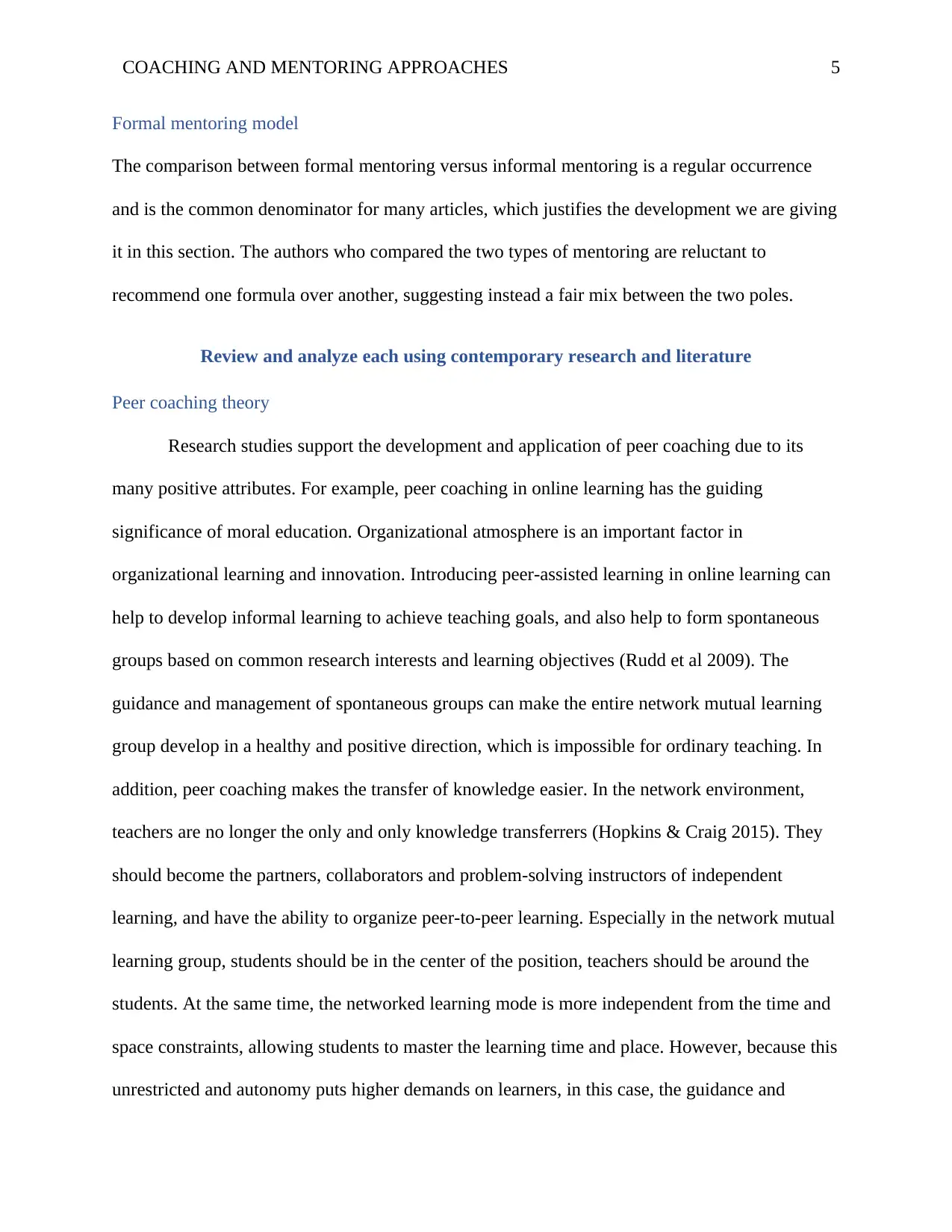
COACHING AND MENTORING APPROACHES 5
Formal mentoring model
The comparison between formal mentoring versus informal mentoring is a regular occurrence
and is the common denominator for many articles, which justifies the development we are giving
it in this section. The authors who compared the two types of mentoring are reluctant to
recommend one formula over another, suggesting instead a fair mix between the two poles.
Review and analyze each using contemporary research and literature
Peer coaching theory
Research studies support the development and application of peer coaching due to its
many positive attributes. For example, peer coaching in online learning has the guiding
significance of moral education. Organizational atmosphere is an important factor in
organizational learning and innovation. Introducing peer-assisted learning in online learning can
help to develop informal learning to achieve teaching goals, and also help to form spontaneous
groups based on common research interests and learning objectives (Rudd et al 2009). The
guidance and management of spontaneous groups can make the entire network mutual learning
group develop in a healthy and positive direction, which is impossible for ordinary teaching. In
addition, peer coaching makes the transfer of knowledge easier. In the network environment,
teachers are no longer the only and only knowledge transferrers (Hopkins & Craig 2015). They
should become the partners, collaborators and problem-solving instructors of independent
learning, and have the ability to organize peer-to-peer learning. Especially in the network mutual
learning group, students should be in the center of the position, teachers should be around the
students. At the same time, the networked learning mode is more independent from the time and
space constraints, allowing students to master the learning time and place. However, because this
unrestricted and autonomy puts higher demands on learners, in this case, the guidance and
Formal mentoring model
The comparison between formal mentoring versus informal mentoring is a regular occurrence
and is the common denominator for many articles, which justifies the development we are giving
it in this section. The authors who compared the two types of mentoring are reluctant to
recommend one formula over another, suggesting instead a fair mix between the two poles.
Review and analyze each using contemporary research and literature
Peer coaching theory
Research studies support the development and application of peer coaching due to its
many positive attributes. For example, peer coaching in online learning has the guiding
significance of moral education. Organizational atmosphere is an important factor in
organizational learning and innovation. Introducing peer-assisted learning in online learning can
help to develop informal learning to achieve teaching goals, and also help to form spontaneous
groups based on common research interests and learning objectives (Rudd et al 2009). The
guidance and management of spontaneous groups can make the entire network mutual learning
group develop in a healthy and positive direction, which is impossible for ordinary teaching. In
addition, peer coaching makes the transfer of knowledge easier. In the network environment,
teachers are no longer the only and only knowledge transferrers (Hopkins & Craig 2015). They
should become the partners, collaborators and problem-solving instructors of independent
learning, and have the ability to organize peer-to-peer learning. Especially in the network mutual
learning group, students should be in the center of the position, teachers should be around the
students. At the same time, the networked learning mode is more independent from the time and
space constraints, allowing students to master the learning time and place. However, because this
unrestricted and autonomy puts higher demands on learners, in this case, the guidance and
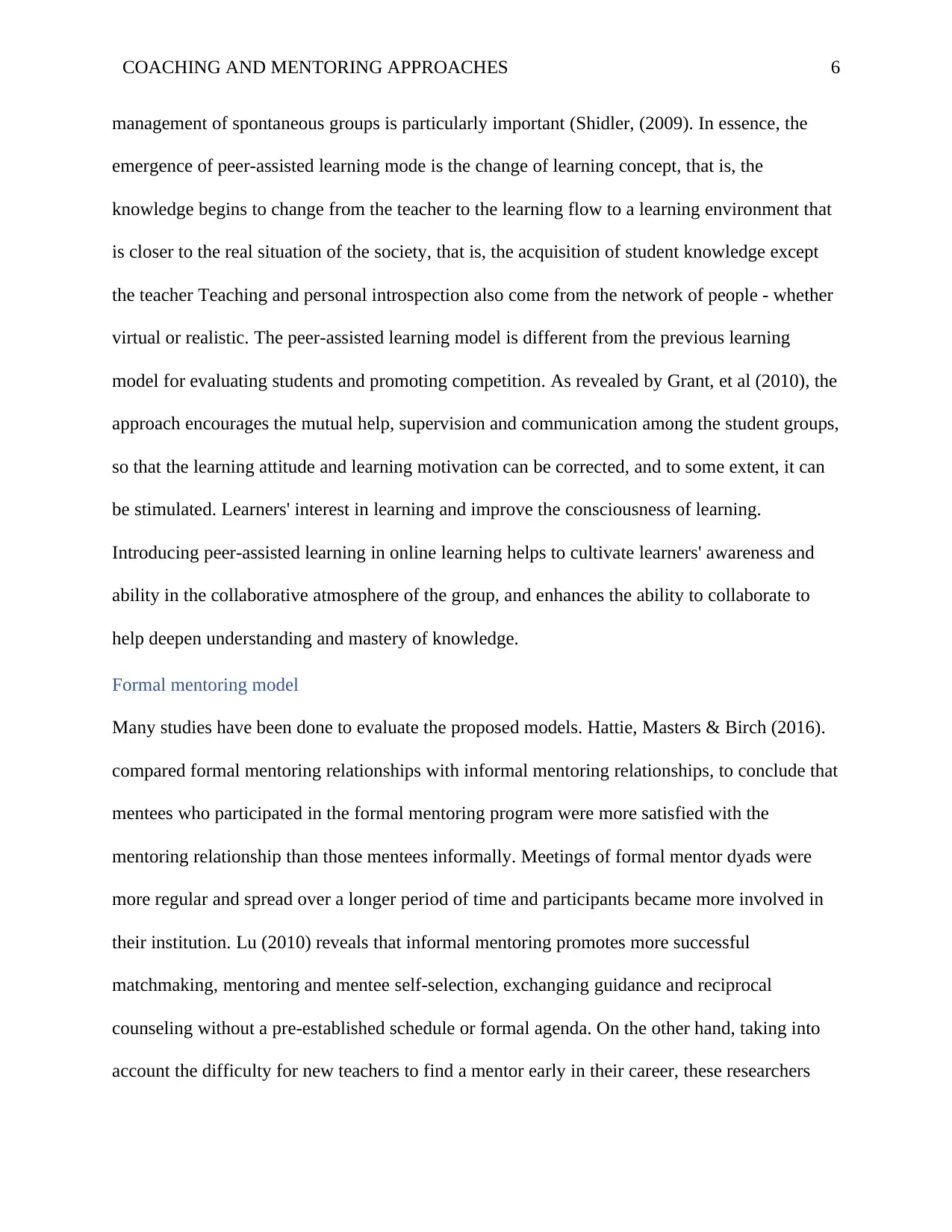
COACHING AND MENTORING APPROACHES 6
management of spontaneous groups is particularly important (Shidler, (2009). In essence, the
emergence of peer-assisted learning mode is the change of learning concept, that is, the
knowledge begins to change from the teacher to the learning flow to a learning environment that
is closer to the real situation of the society, that is, the acquisition of student knowledge except
the teacher Teaching and personal introspection also come from the network of people - whether
virtual or realistic. The peer-assisted learning model is different from the previous learning
model for evaluating students and promoting competition. As revealed by Grant, et al (2010), the
approach encourages the mutual help, supervision and communication among the student groups,
so that the learning attitude and learning motivation can be corrected, and to some extent, it can
be stimulated. Learners' interest in learning and improve the consciousness of learning.
Introducing peer-assisted learning in online learning helps to cultivate learners' awareness and
ability in the collaborative atmosphere of the group, and enhances the ability to collaborate to
help deepen understanding and mastery of knowledge.
Formal mentoring model
Many studies have been done to evaluate the proposed models. Hattie, Masters & Birch (2016).
compared formal mentoring relationships with informal mentoring relationships, to conclude that
mentees who participated in the formal mentoring program were more satisfied with the
mentoring relationship than those mentees informally. Meetings of formal mentor dyads were
more regular and spread over a longer period of time and participants became more involved in
their institution. Lu (2010) reveals that informal mentoring promotes more successful
matchmaking, mentoring and mentee self-selection, exchanging guidance and reciprocal
counseling without a pre-established schedule or formal agenda. On the other hand, taking into
account the difficulty for new teachers to find a mentor early in their career, these researchers
management of spontaneous groups is particularly important (Shidler, (2009). In essence, the
emergence of peer-assisted learning mode is the change of learning concept, that is, the
knowledge begins to change from the teacher to the learning flow to a learning environment that
is closer to the real situation of the society, that is, the acquisition of student knowledge except
the teacher Teaching and personal introspection also come from the network of people - whether
virtual or realistic. The peer-assisted learning model is different from the previous learning
model for evaluating students and promoting competition. As revealed by Grant, et al (2010), the
approach encourages the mutual help, supervision and communication among the student groups,
so that the learning attitude and learning motivation can be corrected, and to some extent, it can
be stimulated. Learners' interest in learning and improve the consciousness of learning.
Introducing peer-assisted learning in online learning helps to cultivate learners' awareness and
ability in the collaborative atmosphere of the group, and enhances the ability to collaborate to
help deepen understanding and mastery of knowledge.
Formal mentoring model
Many studies have been done to evaluate the proposed models. Hattie, Masters & Birch (2016).
compared formal mentoring relationships with informal mentoring relationships, to conclude that
mentees who participated in the formal mentoring program were more satisfied with the
mentoring relationship than those mentees informally. Meetings of formal mentor dyads were
more regular and spread over a longer period of time and participants became more involved in
their institution. Lu (2010) reveals that informal mentoring promotes more successful
matchmaking, mentoring and mentee self-selection, exchanging guidance and reciprocal
counseling without a pre-established schedule or formal agenda. On the other hand, taking into
account the difficulty for new teachers to find a mentor early in their career, these researchers
⊘ This is a preview!⊘
Do you want full access?
Subscribe today to unlock all pages.

Trusted by 1+ million students worldwide
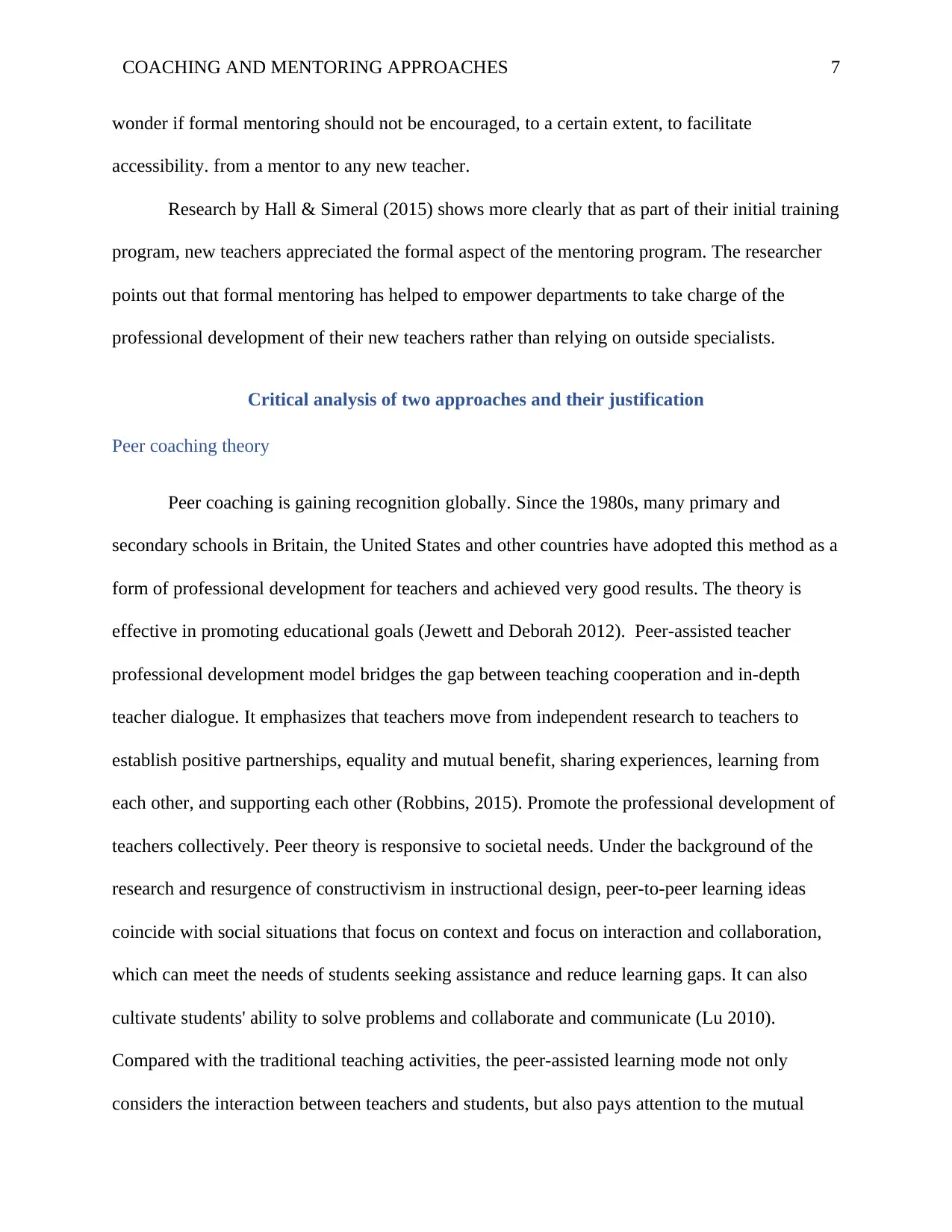
COACHING AND MENTORING APPROACHES 7
wonder if formal mentoring should not be encouraged, to a certain extent, to facilitate
accessibility. from a mentor to any new teacher.
Research by Hall & Simeral (2015) shows more clearly that as part of their initial training
program, new teachers appreciated the formal aspect of the mentoring program. The researcher
points out that formal mentoring has helped to empower departments to take charge of the
professional development of their new teachers rather than relying on outside specialists.
Critical analysis of two approaches and their justification
Peer coaching theory
Peer coaching is gaining recognition globally. Since the 1980s, many primary and
secondary schools in Britain, the United States and other countries have adopted this method as a
form of professional development for teachers and achieved very good results. The theory is
effective in promoting educational goals (Jewett and Deborah 2012). Peer-assisted teacher
professional development model bridges the gap between teaching cooperation and in-depth
teacher dialogue. It emphasizes that teachers move from independent research to teachers to
establish positive partnerships, equality and mutual benefit, sharing experiences, learning from
each other, and supporting each other (Robbins, 2015). Promote the professional development of
teachers collectively. Peer theory is responsive to societal needs. Under the background of the
research and resurgence of constructivism in instructional design, peer-to-peer learning ideas
coincide with social situations that focus on context and focus on interaction and collaboration,
which can meet the needs of students seeking assistance and reduce learning gaps. It can also
cultivate students' ability to solve problems and collaborate and communicate (Lu 2010).
Compared with the traditional teaching activities, the peer-assisted learning mode not only
considers the interaction between teachers and students, but also pays attention to the mutual
wonder if formal mentoring should not be encouraged, to a certain extent, to facilitate
accessibility. from a mentor to any new teacher.
Research by Hall & Simeral (2015) shows more clearly that as part of their initial training
program, new teachers appreciated the formal aspect of the mentoring program. The researcher
points out that formal mentoring has helped to empower departments to take charge of the
professional development of their new teachers rather than relying on outside specialists.
Critical analysis of two approaches and their justification
Peer coaching theory
Peer coaching is gaining recognition globally. Since the 1980s, many primary and
secondary schools in Britain, the United States and other countries have adopted this method as a
form of professional development for teachers and achieved very good results. The theory is
effective in promoting educational goals (Jewett and Deborah 2012). Peer-assisted teacher
professional development model bridges the gap between teaching cooperation and in-depth
teacher dialogue. It emphasizes that teachers move from independent research to teachers to
establish positive partnerships, equality and mutual benefit, sharing experiences, learning from
each other, and supporting each other (Robbins, 2015). Promote the professional development of
teachers collectively. Peer theory is responsive to societal needs. Under the background of the
research and resurgence of constructivism in instructional design, peer-to-peer learning ideas
coincide with social situations that focus on context and focus on interaction and collaboration,
which can meet the needs of students seeking assistance and reduce learning gaps. It can also
cultivate students' ability to solve problems and collaborate and communicate (Lu 2010).
Compared with the traditional teaching activities, the peer-assisted learning mode not only
considers the interaction between teachers and students, but also pays attention to the mutual
Paraphrase This Document
Need a fresh take? Get an instant paraphrase of this document with our AI Paraphraser
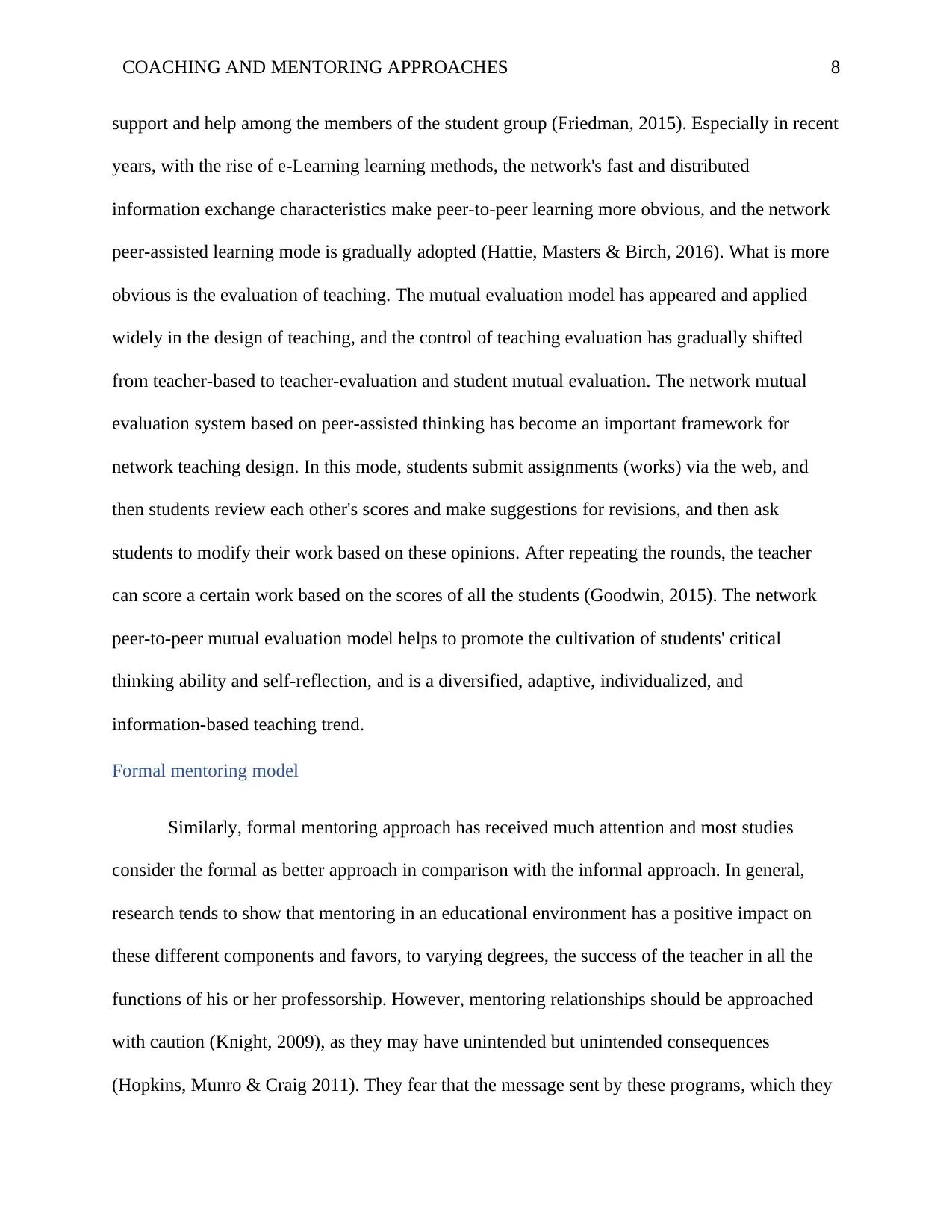
COACHING AND MENTORING APPROACHES 8
support and help among the members of the student group (Friedman, 2015). Especially in recent
years, with the rise of e-Learning learning methods, the network's fast and distributed
information exchange characteristics make peer-to-peer learning more obvious, and the network
peer-assisted learning mode is gradually adopted (Hattie, Masters & Birch, 2016). What is more
obvious is the evaluation of teaching. The mutual evaluation model has appeared and applied
widely in the design of teaching, and the control of teaching evaluation has gradually shifted
from teacher-based to teacher-evaluation and student mutual evaluation. The network mutual
evaluation system based on peer-assisted thinking has become an important framework for
network teaching design. In this mode, students submit assignments (works) via the web, and
then students review each other's scores and make suggestions for revisions, and then ask
students to modify their work based on these opinions. After repeating the rounds, the teacher
can score a certain work based on the scores of all the students (Goodwin, 2015). The network
peer-to-peer mutual evaluation model helps to promote the cultivation of students' critical
thinking ability and self-reflection, and is a diversified, adaptive, individualized, and
information-based teaching trend.
Formal mentoring model
Similarly, formal mentoring approach has received much attention and most studies
consider the formal as better approach in comparison with the informal approach. In general,
research tends to show that mentoring in an educational environment has a positive impact on
these different components and favors, to varying degrees, the success of the teacher in all the
functions of his or her professorship. However, mentoring relationships should be approached
with caution (Knight, 2009), as they may have unintended but unintended consequences
(Hopkins, Munro & Craig 2011). They fear that the message sent by these programs, which they
support and help among the members of the student group (Friedman, 2015). Especially in recent
years, with the rise of e-Learning learning methods, the network's fast and distributed
information exchange characteristics make peer-to-peer learning more obvious, and the network
peer-assisted learning mode is gradually adopted (Hattie, Masters & Birch, 2016). What is more
obvious is the evaluation of teaching. The mutual evaluation model has appeared and applied
widely in the design of teaching, and the control of teaching evaluation has gradually shifted
from teacher-based to teacher-evaluation and student mutual evaluation. The network mutual
evaluation system based on peer-assisted thinking has become an important framework for
network teaching design. In this mode, students submit assignments (works) via the web, and
then students review each other's scores and make suggestions for revisions, and then ask
students to modify their work based on these opinions. After repeating the rounds, the teacher
can score a certain work based on the scores of all the students (Goodwin, 2015). The network
peer-to-peer mutual evaluation model helps to promote the cultivation of students' critical
thinking ability and self-reflection, and is a diversified, adaptive, individualized, and
information-based teaching trend.
Formal mentoring model
Similarly, formal mentoring approach has received much attention and most studies
consider the formal as better approach in comparison with the informal approach. In general,
research tends to show that mentoring in an educational environment has a positive impact on
these different components and favors, to varying degrees, the success of the teacher in all the
functions of his or her professorship. However, mentoring relationships should be approached
with caution (Knight, 2009), as they may have unintended but unintended consequences
(Hopkins, Munro & Craig 2011). They fear that the message sent by these programs, which they
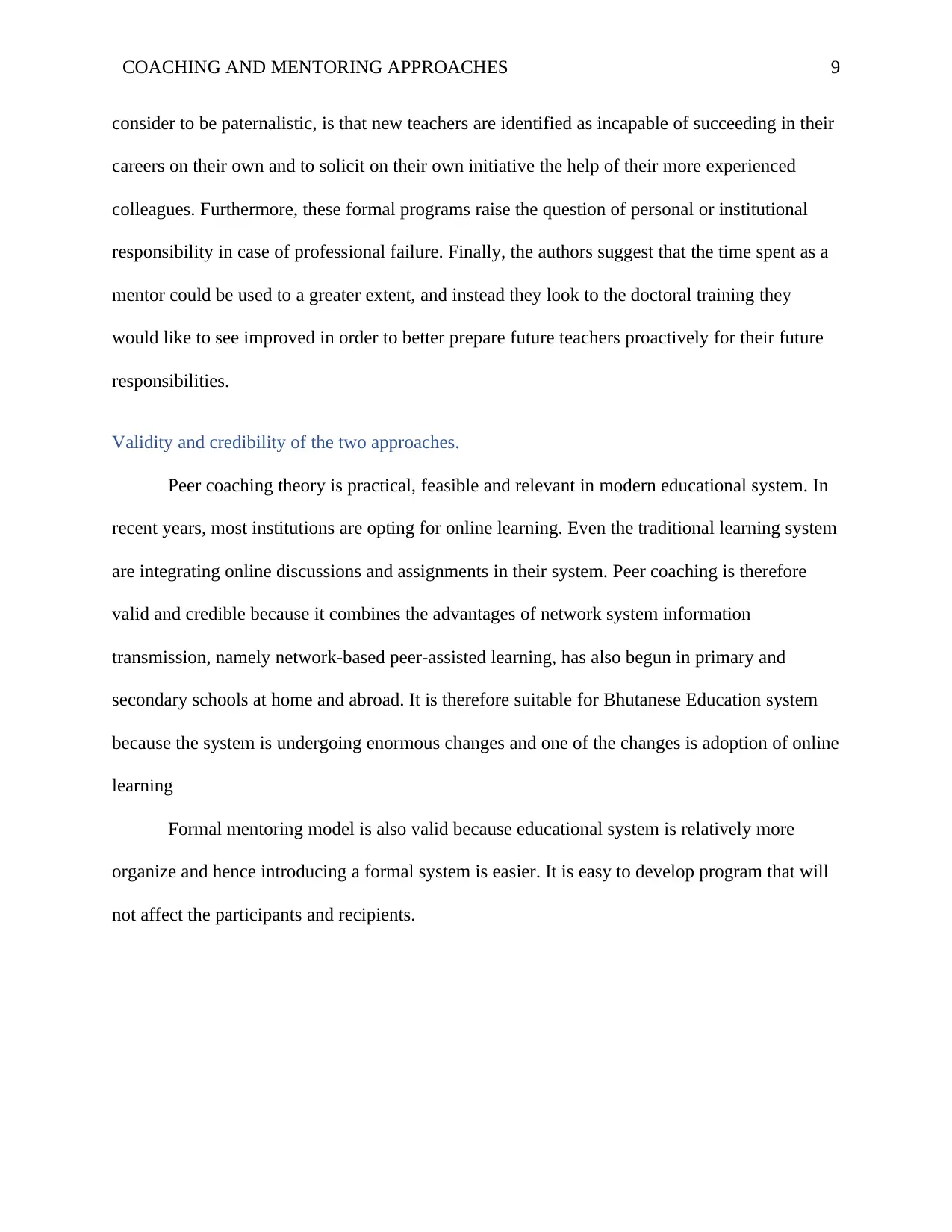
COACHING AND MENTORING APPROACHES 9
consider to be paternalistic, is that new teachers are identified as incapable of succeeding in their
careers on their own and to solicit on their own initiative the help of their more experienced
colleagues. Furthermore, these formal programs raise the question of personal or institutional
responsibility in case of professional failure. Finally, the authors suggest that the time spent as a
mentor could be used to a greater extent, and instead they look to the doctoral training they
would like to see improved in order to better prepare future teachers proactively for their future
responsibilities.
Validity and credibility of the two approaches.
Peer coaching theory is practical, feasible and relevant in modern educational system. In
recent years, most institutions are opting for online learning. Even the traditional learning system
are integrating online discussions and assignments in their system. Peer coaching is therefore
valid and credible because it combines the advantages of network system information
transmission, namely network-based peer-assisted learning, has also begun in primary and
secondary schools at home and abroad. It is therefore suitable for Bhutanese Education system
because the system is undergoing enormous changes and one of the changes is adoption of online
learning
Formal mentoring model is also valid because educational system is relatively more
organize and hence introducing a formal system is easier. It is easy to develop program that will
not affect the participants and recipients.
consider to be paternalistic, is that new teachers are identified as incapable of succeeding in their
careers on their own and to solicit on their own initiative the help of their more experienced
colleagues. Furthermore, these formal programs raise the question of personal or institutional
responsibility in case of professional failure. Finally, the authors suggest that the time spent as a
mentor could be used to a greater extent, and instead they look to the doctoral training they
would like to see improved in order to better prepare future teachers proactively for their future
responsibilities.
Validity and credibility of the two approaches.
Peer coaching theory is practical, feasible and relevant in modern educational system. In
recent years, most institutions are opting for online learning. Even the traditional learning system
are integrating online discussions and assignments in their system. Peer coaching is therefore
valid and credible because it combines the advantages of network system information
transmission, namely network-based peer-assisted learning, has also begun in primary and
secondary schools at home and abroad. It is therefore suitable for Bhutanese Education system
because the system is undergoing enormous changes and one of the changes is adoption of online
learning
Formal mentoring model is also valid because educational system is relatively more
organize and hence introducing a formal system is easier. It is easy to develop program that will
not affect the participants and recipients.
⊘ This is a preview!⊘
Do you want full access?
Subscribe today to unlock all pages.

Trusted by 1+ million students worldwide
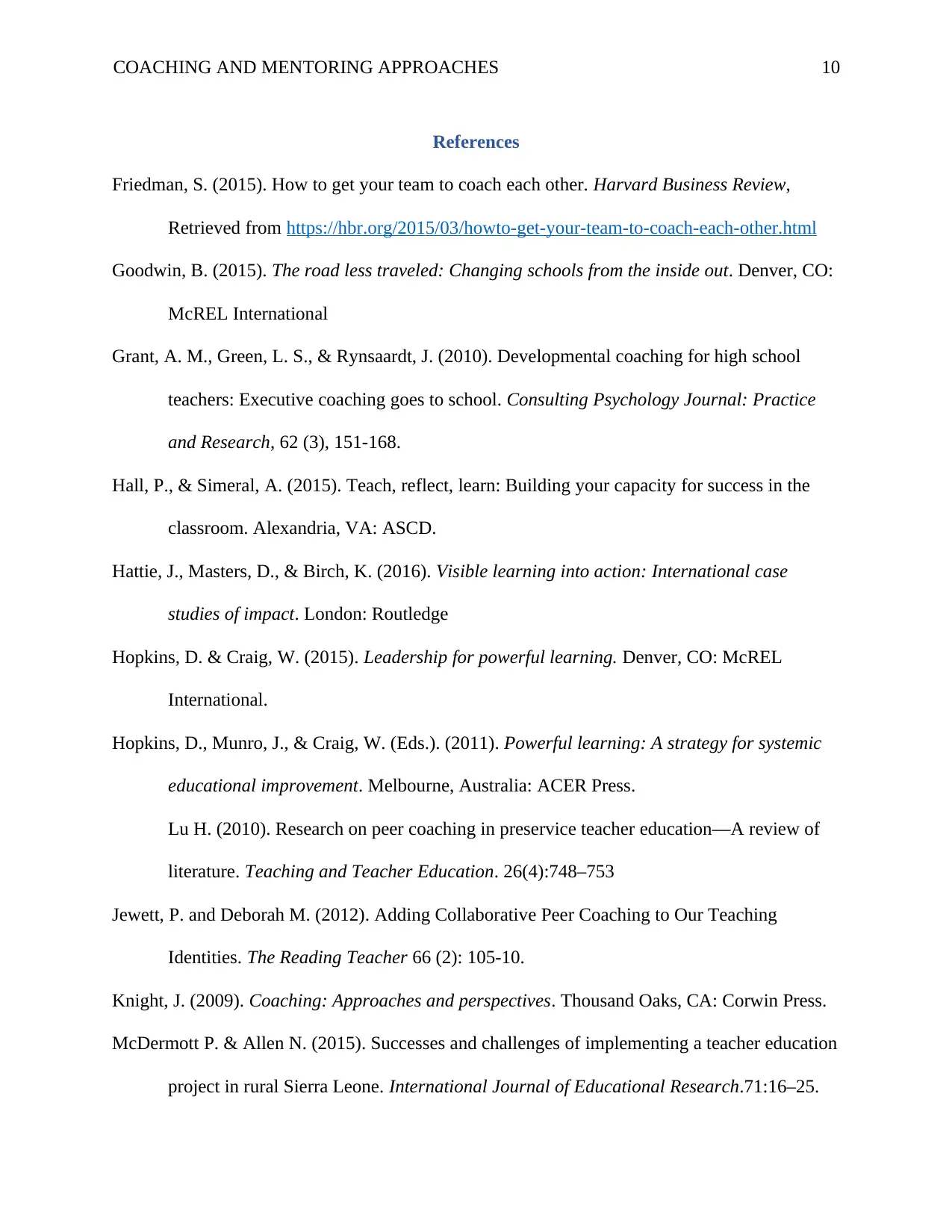
COACHING AND MENTORING APPROACHES 10
References
Friedman, S. (2015). How to get your team to coach each other. Harvard Business Review,
Retrieved from https://hbr.org/2015/03/howto-get-your-team-to-coach-each-other.html
Goodwin, B. (2015). The road less traveled: Changing schools from the inside out. Denver, CO:
McREL International
Grant, A. M., Green, L. S., & Rynsaardt, J. (2010). Developmental coaching for high school
teachers: Executive coaching goes to school. Consulting Psychology Journal: Practice
and Research, 62 (3), 151-168.
Hall, P., & Simeral, A. (2015). Teach, reflect, learn: Building your capacity for success in the
classroom. Alexandria, VA: ASCD.
Hattie, J., Masters, D., & Birch, K. (2016). Visible learning into action: International case
studies of impact. London: Routledge
Hopkins, D. & Craig, W. (2015). Leadership for powerful learning. Denver, CO: McREL
International.
Hopkins, D., Munro, J., & Craig, W. (Eds.). (2011). Powerful learning: A strategy for systemic
educational improvement. Melbourne, Australia: ACER Press.
Lu H. (2010). Research on peer coaching in preservice teacher education—A review of
literature. Teaching and Teacher Education. 26(4):748–753
Jewett, P. and Deborah M. (2012). Adding Collaborative Peer Coaching to Our Teaching
Identities. The Reading Teacher 66 (2): 105-10.
Knight, J. (2009). Coaching: Approaches and perspectives. Thousand Oaks, CA: Corwin Press.
McDermott P. & Allen N. (2015). Successes and challenges of implementing a teacher education
project in rural Sierra Leone. International Journal of Educational Research.71:16–25.
References
Friedman, S. (2015). How to get your team to coach each other. Harvard Business Review,
Retrieved from https://hbr.org/2015/03/howto-get-your-team-to-coach-each-other.html
Goodwin, B. (2015). The road less traveled: Changing schools from the inside out. Denver, CO:
McREL International
Grant, A. M., Green, L. S., & Rynsaardt, J. (2010). Developmental coaching for high school
teachers: Executive coaching goes to school. Consulting Psychology Journal: Practice
and Research, 62 (3), 151-168.
Hall, P., & Simeral, A. (2015). Teach, reflect, learn: Building your capacity for success in the
classroom. Alexandria, VA: ASCD.
Hattie, J., Masters, D., & Birch, K. (2016). Visible learning into action: International case
studies of impact. London: Routledge
Hopkins, D. & Craig, W. (2015). Leadership for powerful learning. Denver, CO: McREL
International.
Hopkins, D., Munro, J., & Craig, W. (Eds.). (2011). Powerful learning: A strategy for systemic
educational improvement. Melbourne, Australia: ACER Press.
Lu H. (2010). Research on peer coaching in preservice teacher education—A review of
literature. Teaching and Teacher Education. 26(4):748–753
Jewett, P. and Deborah M. (2012). Adding Collaborative Peer Coaching to Our Teaching
Identities. The Reading Teacher 66 (2): 105-10.
Knight, J. (2009). Coaching: Approaches and perspectives. Thousand Oaks, CA: Corwin Press.
McDermott P. & Allen N. (2015). Successes and challenges of implementing a teacher education
project in rural Sierra Leone. International Journal of Educational Research.71:16–25.
Paraphrase This Document
Need a fresh take? Get an instant paraphrase of this document with our AI Paraphraser
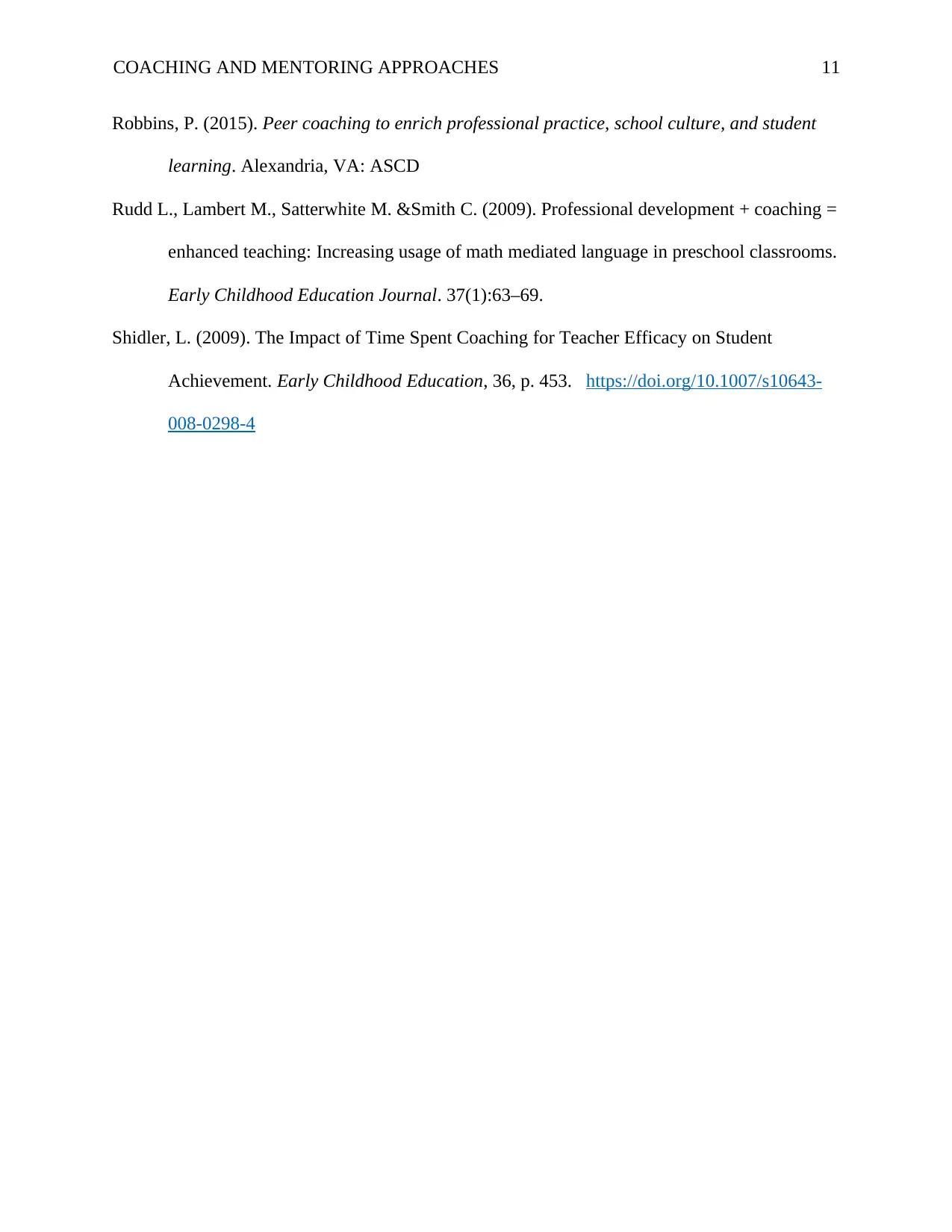
COACHING AND MENTORING APPROACHES 11
Robbins, P. (2015). Peer coaching to enrich professional practice, school culture, and student
learning. Alexandria, VA: ASCD
Rudd L., Lambert M., Satterwhite M. &Smith C. (2009). Professional development + coaching =
enhanced teaching: Increasing usage of math mediated language in preschool classrooms.
Early Childhood Education Journal. 37(1):63–69.
Shidler, L. (2009). The Impact of Time Spent Coaching for Teacher Efficacy on Student
Achievement. Early Childhood Education, 36, p. 453. https://doi.org/10.1007/s10643-
008-0298-4
Robbins, P. (2015). Peer coaching to enrich professional practice, school culture, and student
learning. Alexandria, VA: ASCD
Rudd L., Lambert M., Satterwhite M. &Smith C. (2009). Professional development + coaching =
enhanced teaching: Increasing usage of math mediated language in preschool classrooms.
Early Childhood Education Journal. 37(1):63–69.
Shidler, L. (2009). The Impact of Time Spent Coaching for Teacher Efficacy on Student
Achievement. Early Childhood Education, 36, p. 453. https://doi.org/10.1007/s10643-
008-0298-4
1 out of 11
Related Documents
Your All-in-One AI-Powered Toolkit for Academic Success.
+13062052269
info@desklib.com
Available 24*7 on WhatsApp / Email
![[object Object]](/_next/static/media/star-bottom.7253800d.svg)
Unlock your academic potential
Copyright © 2020–2025 A2Z Services. All Rights Reserved. Developed and managed by ZUCOL.



